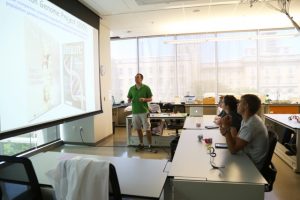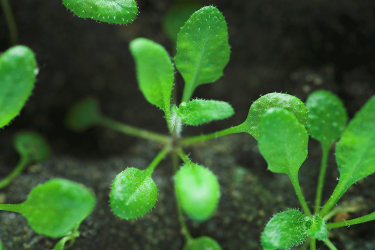We all start as a single cell: a fertilized egg. Researchers are learning more every year about how certain proteins in our cells called transcription factors turn on or off genes in meticulous, intricate patterns. They allow single cells to develop into nerve cells and heart cells, skin cells and spleen cells, and all the other kinds of cells that make up a living, breathing, talking, texting human being.

“But,” asks Xuehua Zhong, an assistant professor in the Wisconsin Institute for Discovery Epigenetics theme and in the Genetics department at the University of Wisconsin-Madison, “what is controlling the transcription factors?”
That’s one of the scientific mysteries Zhong is looking to get to the bottom of through her research. She is trying to understand how genes are turned on or off to different degrees without any changes to their underlying DNA sequences; in other words not genetic changes but epigenetic ones.
Epigenetics literally means “above” or “in addition to” genetics. It is a branch of biology that includes the study of chemical tags added on to our DNA as well as proteins called histones that organize the DNA in our cells. These factors can affect a host of biological processes ranging from proper growth and development to cancer and other diseases.
“Our environment can have huge effects on our development and evolution,” says Zhong. “Epigenetic changes allow us to be more flexible because they are reversible.” In environments that may cycle between different conditions, being able to make temporary changes to how our genes behave without permanently changing the genetic code is a huge advantage.
“Our environment can have huge effects on our development and evolution.”
-Xuehua Zhong
Think of our entire genetic code as a giant recipe book, with instructions to make foods for a variety of different occasions. But what happens if there is no information about what foods are ideal for specific occasions? Burgers and dips may be great for a small party with friends to watch the Packers win the Super Bowl, but they may not be as appropriate for a black-tie dinner party for hundreds of people.
Epigenetic signals act like a series of post-it notes directing the chef to create a meal appropriate for the event. Within our cells epigenetic changes add chemical tags to DNAs or proteins that act as guidelines for our cellular machinery in different cell types. The recipes for various proteins – contained in our genetic code – stay the same, but the post-its provide information about which proteins and how much of each protein to make depending on specific cell types.
One kind of epigenetic change that directly affects our DNA is called DNA methylation. A small chemical tag, called a methyl group, is placed at specific locations on our DNA and “though this does not change the underlying DNA sequence, it does change how that gene is expressed,” says Zhong.
But studying how DNA methylation affects human development, disease and functioning is a challege. It turns out that DNA methylation, while crucially important in mammals, is absent or present in very small amounts in some other model organisms that scientists study in the lab. Mice, which do have DNA methylation, are difficult to study because deleting the genes that make proteins responsible for DNA methylation is lethal.
That leaves Dr. Zhong with Arabidopsis thaliana, a scraggly-looking relative of mustard plant. “Even though flowering plants, like Arabidopsis, are affected by the deletion of genes that make DNA methylation proteins, they are still viable,” says Zhong. “That allows us to study what happens in the absence of DNA methylation in a physiologically relevant context.”

Zhong acknowledges there is an evolutionary gap between humans and flowering plants. But importantly, there is a great deal of similarity – or conservation – in the structure of proteins called methyltransferases, which place methyl tags on DNA, in Arabidopsis and mammals.
“Methyltransferases are ancient proteins,” says Zhong, “and because their structure and function are conserved between plants and mammals, we can gain important information about DNA methylation in humans by studying flowering plants, such as Arabidopsis.”
Zhong’s lab focuses on trying to understand not only how the post-it notes of DNA methylation are written in our cells, but also on identifying which proteins ‘read’ these epigenetic directions and how they then carry out the instructions. She is also trying to determine whether these epigenetic changes can be inherited and how permanent they can be.
According to Zhong, these are big questions that will take more than one person to answer. That’s part of the reason why she is dedicated to taking the stories that make science rich and multi-layered to as many people as possible through a variety of outreach activities.
For example, a bevy of high school and undergraduate students work with Zhong in her laboratory. Zhong tries to connect what her students are studying in the classroom with experiments in the lab, “which allows them to really understand the science and see it in action,” she says.
“The earlier someone is involved in research, the earlier he or she can get a true idea of what it is like to be a scientist,” she says. “My philosophy is to connect these young people with science and scientists, and it has been a tremendously enjoyable and rewarding experience for me.”
–Adityarup Chakravorty


You must be logged in to post a comment.